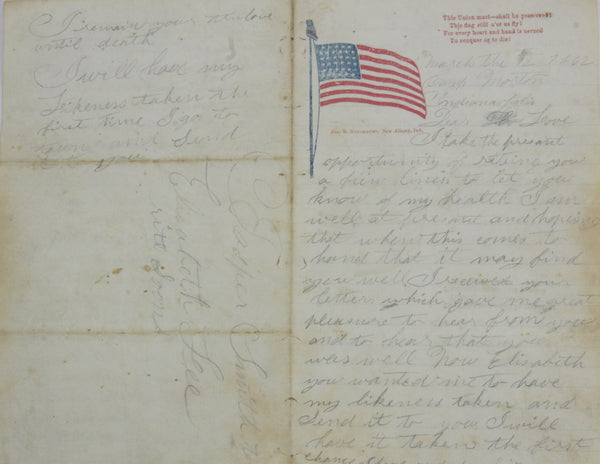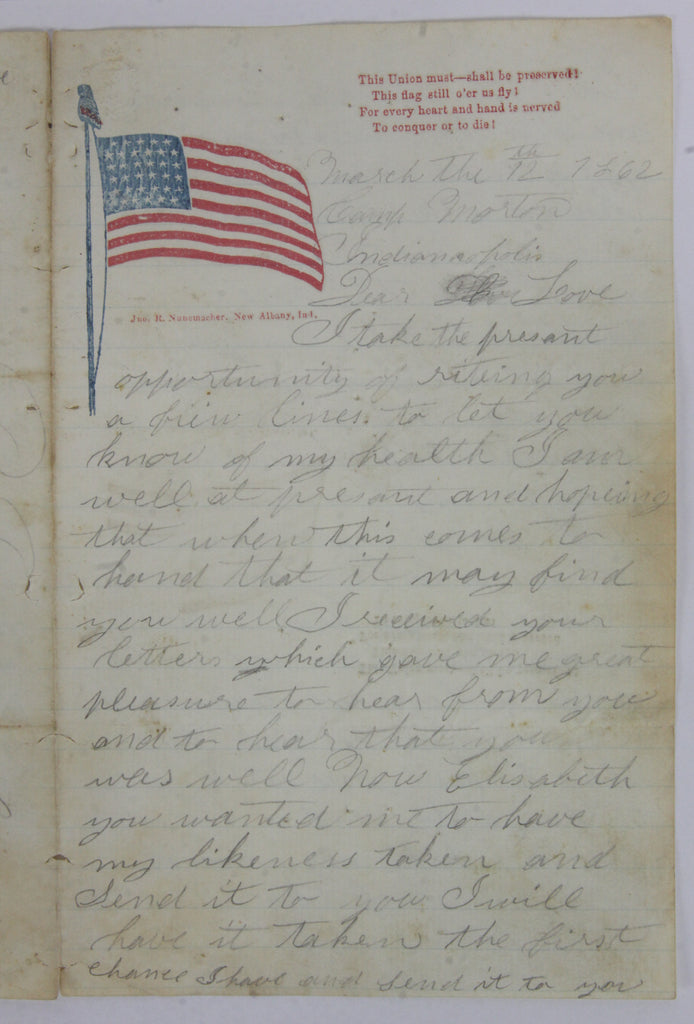Life, Love and the American Civil War - Civil War Letters Part I


|
NAME |
RELATION |
UNIT |
# LETTERS |
|
JASPER N. SMITH |
COURTING ELIZABETH |
COMPANY K 53RD INDIANA VETERAN VOLUNTEER 1ST BRIGADE, 4TH DIVISION ARMY CORPS OF TENNESSEE |
92 LETTERS, 1 CO-WRITTEN |
|
HENRY LEE |
ELIZABETH’S BROTHER |
ENGINEER CORPS 1ST BRIGADE, 2ND DIVISION16TH ARMY CORPS & COMPANY A 66TH REGIMENT VOLUNTEERS INDIANA |
6 LETTERS, 1 CO-WRITTEN |
|
CHRISTOPHER SMITH |
JASPER’S BROTHER |
COMPANY A 66TH REGIMENT INDIANA KILLED IN ACTION |
1 LETTER, CO-WRITTEN |
|
GREGORY LEE |
ELIZABETH’S BROTHER |
COMPANY A 66TH REGIMENT INDIANA VOLUNTEER |
9 LETTERS, 3 CO- WRITTEN |
|
ELIJAH MILLER |
ELIZABETH’S NEPHEW |
COMPANY A 140TH REGIMENT INDIANA VOLUNTEER |
7 LETTERS |
|
CP LEATHERMAN |
ELIZABETH’S COUSIN |
1 LETTER |
|
|
ABRAHAM TENGARDEN |
JASPER’S LIEUTENANT |
||
|
JOHN A. SMITH |
ELIZABETH’S NEPHEW |
1 LETTER, CO-WRITTEN |
|
|
CAM RANSOM LEE |
ELIZABETH’S BROTHER |
CORPORAL IN COMPANY A, 38TH INDIANA INFANTRY ENLISTED SEPTEMBER 17, 1861 |
With 92 letters having been written by Jasper, this story truly belongs to him and the recipient, Elizabeth, with the others playing supporting roles. Both Jasper and Elizabeth were raised in southern Indiana, born in the 1840’s. Jasper as the son of John Andrew and Elizabeth (Broadway) Smith. Elizabeth was the daughter of Isaac and Henriette Dorothy (Leatherman) Lee.
As we poured over these letters, we were given the opportunity to research the lives of these amazing individuals. A lot of our research lead us to one website: Find a Grave. Find a Grave is “a free resource for finding the final resting places of famous folks, friends and family members.” The site provides as much information as it has available. For many, the information is abundant. Jasper’s Find a Grave page provided us with his birth and death dates and locations, the names of his parents, siblings, spouse and children (with links to each of their own pages) and the location of his burial. After reading hundreds of pages written from Jasper’s own hand. we were thrilled to see that someone had also posted two pictures of Jasper himself.
This picture was obviously taken later in his life, but this is our beloved letter writer.

The picture was captioned, “Jasper Smith fishing, something he loved to do.”
Years before that picture was captured, The United States of America was facing difficult days. Abraham Lincoln was sworn in as the 16th president on March 4, 1861. The decade before his presidency began, conflict grew between the northern and southern states. The conflict reached its boiling point on April 12, 1861, when Confederate soldiers opened fire on Fort Sumter in South Carolina. Those cannon shots marked the beginning of the Civil War.
On February 2, 1862, shortly following his nineteenth birthday, Jasper Newton Smith arrived in Indianapolis, Indiana, where he enrolled to join the military. He was a Union soldier, a member of the 53rd Regiment of the Indiana Infantry. Through his heavy handed script, Jasper’s letters detail his days as a soldier in the American Civil War. As he writes, he discusses battles, war strategy and specific moments and people made famous by the war.In the midst of bloodshed, “normal” life continues. Jasper uses his letters to court young Elizabeth Lee. It is clear that Jasper and Elizabeth (affectionately known as “Betty”) had some level of a relationship before he left for war, but we do not know anything more than that. It is also apparent that Jasper is smitten with Elizabeth. He confesses his love to her throughout each letter, amidst discussion of his current surroundings, health, friends and family, war activity, and wonderings of life back home. Often, Jasper includes a poem or song for Elizabeth’s enjoyment.
Over the next couple of months, we will be sharing with you our collection of Civil War letters, and the lives of Jasper, Elizabeth and their families and friends. We sincerely hope that you enjoy their story as much as we have.

Dear Love,
I remain your true love until death
Leave a comment
Also in View from the RoofTop
Transformation Tuesday - Wall Decor Letters
A New Perspective for Today: An Eloquent Monkey
Frankly, I am not fond of monkeys. They affect me the way spiders and snakes affect other people. The flying monkeys in “The Wizard of Oz” and the rogue monkeys in Robin Williams’s “Jumanji” were menacing to me, and I closed my eyes so I wouldn’t have to see them.
One Day, One Mall, and Four Booths
We headed to Columbia on Saturday morning to meet a new online acquaintance for a furniture trade. I didn't realize it at the time, but the Willett Mid-Century Modern end table she placed in our hands would become the centerpiece for a collection of untold treasures.






